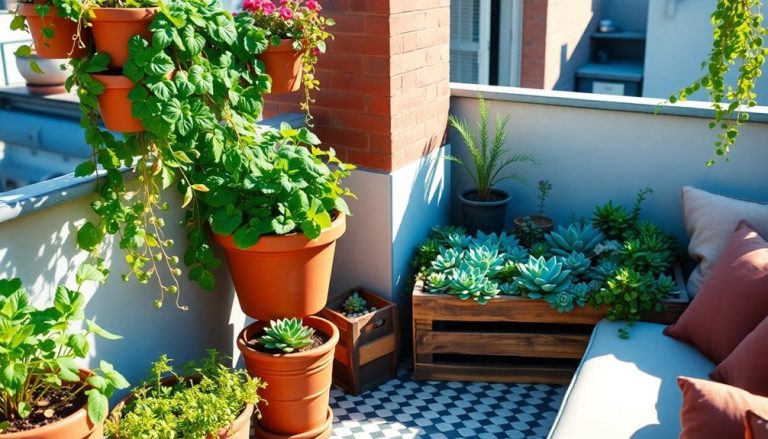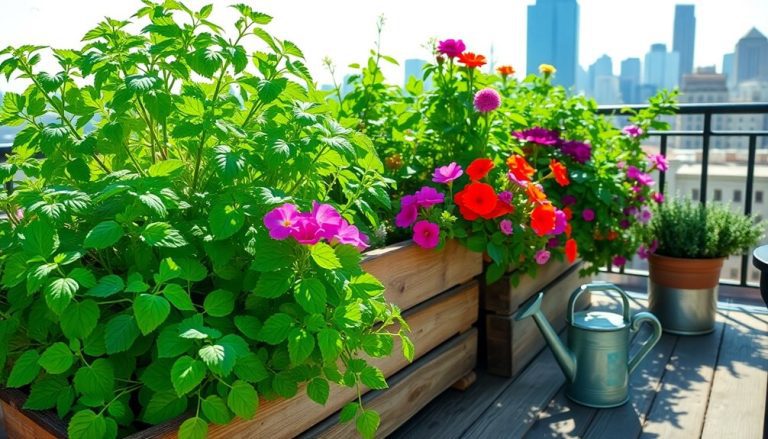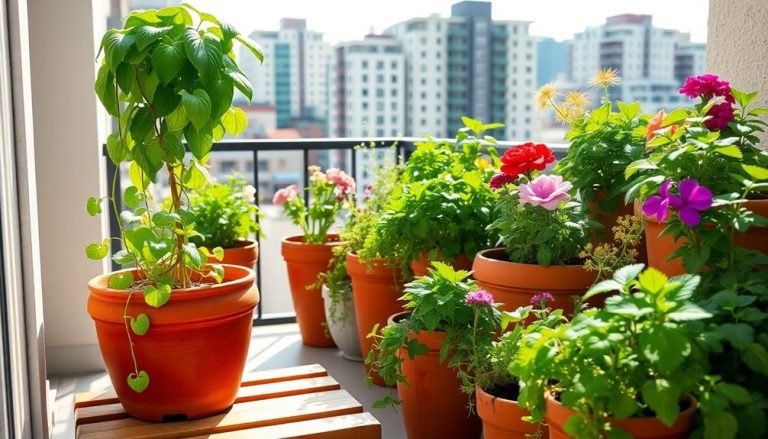If you're looking to brighten up low-light areas in your home, consider these indoor plants. The Snake Plant and ZZ Plant thrive in dim spaces with minimal care. Pothos adapts to varying light conditions and grows quickly. Peace Lilies add elegance with their white blooms while purifying the air. Spider Plants are adaptable and produce cute "pups" for propagation. Each of these plants not only survives but flourishes without direct sunlight. They're perfect for any room. Want to know more about their care tips and specific benefits? There's plenty more to discover!
Key Takeaways
- Snake Plant and ZZ Plant thrive in low light, requiring minimal care and infrequent watering.
- Pothos is versatile, adapting to various light conditions and known for its air-purifying qualities.
- Peace Lily blooms beautifully in low light, improving indoor air quality while tolerating occasional neglect.
- Spider Plant is easy to care for, adaptable to low light, and produces "pups" for propagation.
- Monitor watering and humidity levels to prevent issues like root rot, especially in low-light environments.
Snake Plant

The Snake Plant, also known as Sansevieria, is a fantastic choice for anyone looking to brighten up a low-light space. You'll love its striking, upright leaves that come in various shades of green, often with beautiful yellow or white edges.
This plant's hardy nature means it thrives with minimal care, making it perfect for those who might forget to water regularly.
One of the standout features of the Snake Plant is its ability to tolerate low light conditions. You can place it in a dim corner of your living room, office, or even a bathroom, and it'll still flourish.
It's also known for improving indoor air quality by filtering out toxins, so you're not just adding greenery; you're enhancing your environment too.
Caring for your Snake Plant is simple. Water it every couple of weeks, allowing the soil to dry out between waterings.
It's also resistant to pests, which means you won't have to worry much about infestations.
With its unique look and low maintenance requirements, the Snake Plant is an excellent addition to your indoor plant collection. You'll appreciate how it complements your decor while thriving in less-than-ideal light conditions.
Pothos
If you're looking to liven up a low-light area, consider adding Pothos to your collection. This hardy plant thrives in various lighting conditions, making it perfect for dimly lit spaces. With its trailing vines and heart-shaped leaves, Pothos can add a touch of greenery to any room.
One of the best things about Pothos is its adaptability. You won't need to fuss over it; just water when the soil feels dry. It can even tolerate neglect, which is ideal if you're not the most attentive plant parent. Plus, it's known for its air-purifying qualities, helping to improve your indoor air quality.
Here's a quick overview of Pothos:
| Feature | Details |
|---|---|
| Light Requirements | Low to bright indirect light |
| Watering | Allow soil to dry between waterings |
| Growth Rate | Fast-growing, can reach 10+ feet |
| Toxicity | Mildly toxic to pets and humans |
| Maintenance | Low maintenance; easy to propagate |
ZZ Plant
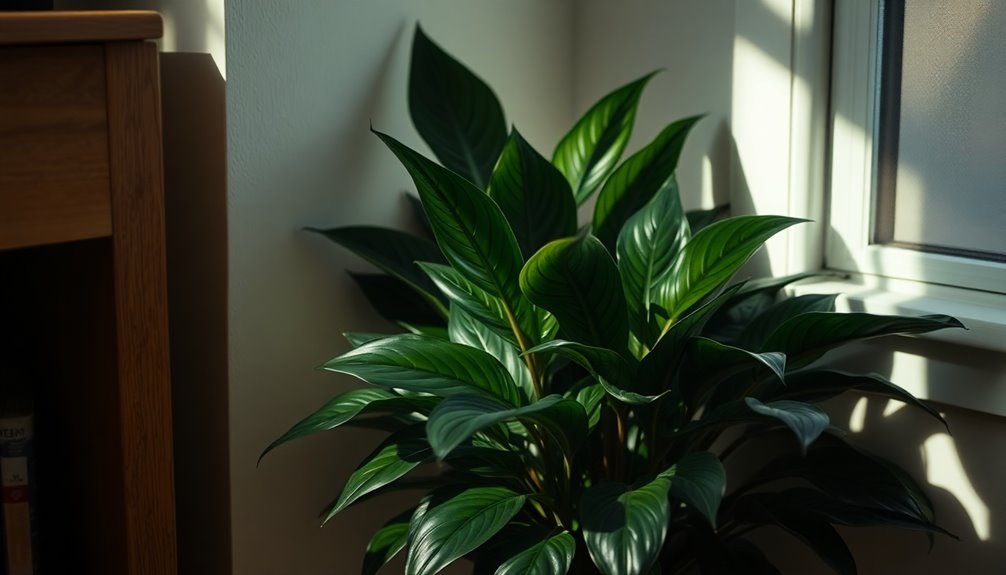
For anyone seeking a resilient indoor plant, the ZZ Plant is an excellent choice. Known scientifically as Zamioculcas zamiifolia, this plant thrives in low light conditions, making it perfect for dimly lit spaces.
You'll appreciate its glossy, dark green leaves that not only add a touch of elegance to your home but also tolerate neglect, which is great if you're not always attentive to plant care.
The ZZ Plant requires minimal watering, so you won't need to worry about overwatering. Just allow the soil to dry out completely between waterings, and it'll be happy.
It's also quite forgiving of a range of indoor temperatures, but it prefers a warm environment.
To keep your ZZ Plant looking its best, place it in a pot with good drainage. You can also wipe the leaves occasionally to remove dust, allowing the plant to absorb light more effectively.
If you're looking to propagate, it can easily be done through leaf cuttings, though it's a slower process.
With its hardiness and low-maintenance requirements, the ZZ Plant is a fantastic option for both beginners and seasoned plant enthusiasts alike.
Peace Lily
Another excellent choice for low light conditions is the Peace Lily, scientifically known as Spathiphyllum. This lovely plant not only thrives in low light but also adds a touch of elegance to any space with its glossy green leaves and striking white blooms.
If you're looking to enhance your indoor environment, the Peace Lily is a fantastic option.
Caring for a Peace Lily is simple. It prefers to be kept in indirect sunlight, so you can place it in a north or east-facing window, or even a few feet away from a window.
Water it when the top inch of soil feels dry, but be careful not to overwater, as it can lead to root rot.
One of the standout features of the Peace Lily is its air-purifying qualities. It helps remove common indoor pollutants, making your home healthier.
Plus, it's a tolerant plant, meaning it can bounce back if you forget to water it occasionally.
With minimal maintenance and stunning aesthetics, the Peace Lily is a perfect choice for anyone wanting to brighten up their low-light spaces.
Spider Plant
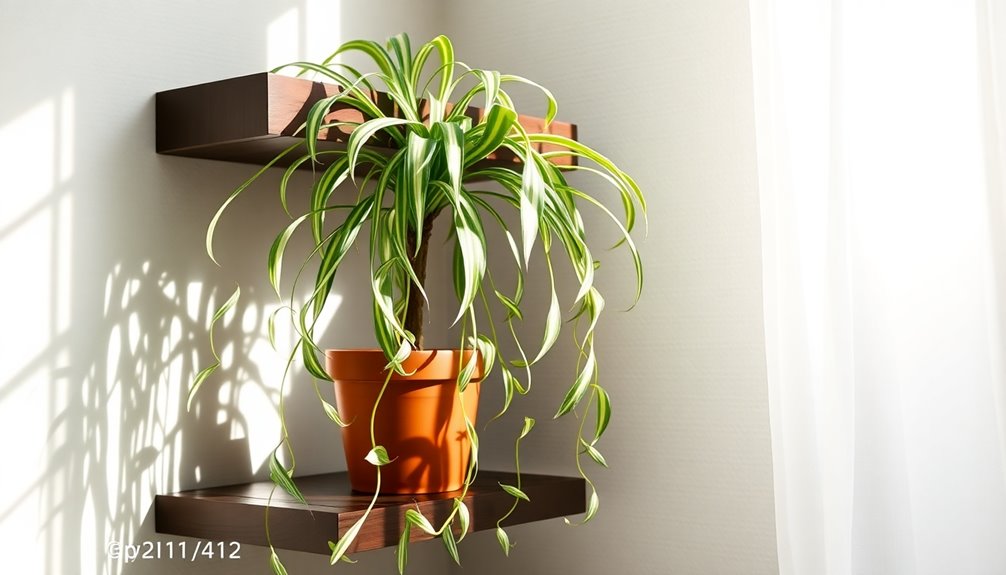
Few plants are as adaptable and resilient as the Spider Plant, scientifically known as Chlorophytum comosum. This charming houseplant thrives in low light, making it perfect for your dimly lit spaces. You'll love how easy it's to care for; just keep the soil slightly moist and watch it flourish.
One of the standout features of the Spider Plant is its unique arching leaves, which can be solid green or variegated with white or yellow stripes. These attractive leaves not only brighten up your room but also help purify the air, creating a healthier environment for you.
Plus, it's known for producing "pups," or baby plants, that you can propagate and share with friends or expand your indoor garden.
Don't worry too much about humidity, as the Spider Plant tolerates a range of conditions. However, it appreciates occasional misting, especially in dry environments.
Just be cautious of overwatering, as this can lead to root rot. With minimal effort, you'll enjoy a thriving Spider Plant that adds a touch of nature and vibrancy to your home.
Cast Iron Plant
Although it may not be the flashiest plant in your collection, the Cast Iron Plant, scientifically known as Aspidistra elatior, is a true champion of resilience in low-light conditions. This hardy plant thrives in neglect, making it perfect for those who mightn't have a green thumb.
Here's how to make the most of your Cast Iron Plant:
- Location: Place it in a spot that receives indirect light. It tolerates low-light areas, but it'll appreciate any little bit of brightness you can provide.
- Watering: Only water it when the top inch of soil feels dry. Overwatering can lead to root rot, so it's better to err on the side of caution.
- Temperature: Keep it in a temperature range between 60°F to 75°F. It's not fond of extreme cold or heat.
- Fertilizing: Feed it with a balanced fertilizer every few months during the growing season. This will help maintain its lush green leaves.
With minimal care, you'll find that the Cast Iron Plant can be a reliable and attractive addition to your indoor garden.
Dracaena
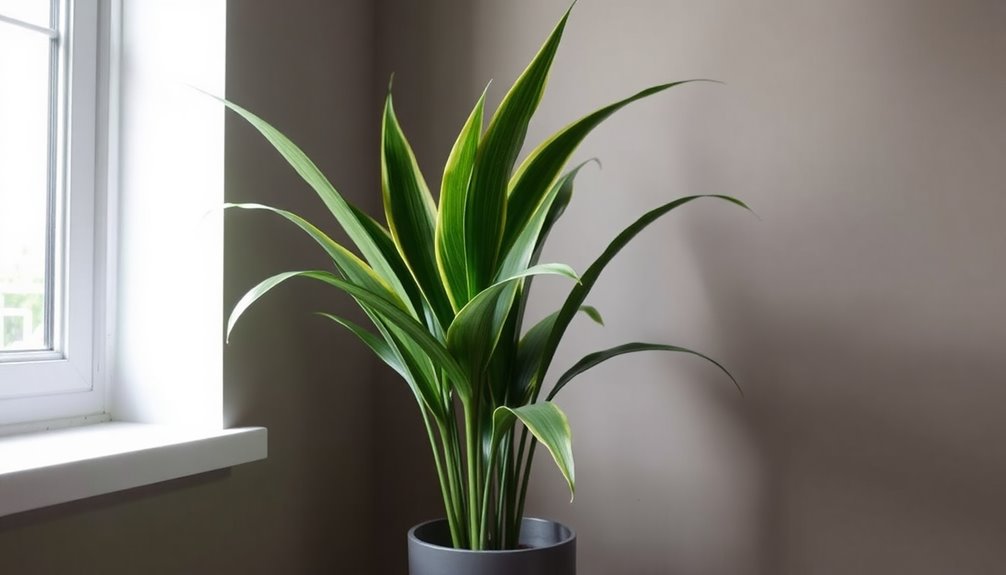
Dracaena is a popular choice for indoor gardening enthusiasts looking for a low-maintenance plant that flourishes in dim lighting. With its striking foliage and variety of species, Dracaena can easily enhance your home decor. These plants can tolerate neglect, making them perfect for busy lifestyles.
You'll find Dracaena varieties like the Dracaena marginata and Dracaena fragrans, each with unique leaf patterns and colors. They thrive in indirect sunlight but can adapt to low-light situations, allowing you to place them in darker corners of your home.
Here's a quick comparison of some popular Dracaena varieties:
| Dracaena Variety | Height (ft) |
|---|---|
| Dracaena marginata | 4-6 |
| Dracaena fragrans | 4-10 |
| Dracaena sanderiana | 3-4 |
| Dracaena reflexa | 3-6 |
| Dracaena surculosa | 2-4 |
Caring for your Dracaena is simple. Just water it when the top inch of soil feels dry, and avoid overwatering. With minimal effort, you'll enjoy a beautiful, thriving indoor plant!
Philodendron
When it comes to low-light indoor plants, Philodendrons stand out for their lush foliage and easy-going nature.
These tropical beauties thrive in lower light conditions and can adapt to your home's environment with ease. Not only are they visually appealing, but they also purify the air, making your space healthier.
To care for your Philodendron, keep these tips in mind:
- Light: Place your plant in indirect light. They can tolerate low light, but bright, indirect light helps them grow better.
- Watering: Water when the top inch of soil feels dry. Overwatering can lead to root rot, so be cautious.
- Humidity: These plants enjoy humidity. If your home is dry, consider misting them or using a pebble tray.
- Fertilizing: Feed your Philodendron with a balanced fertilizer every 4-6 weeks during the growing season for optimal growth.
With minimal effort, your Philodendron will thrive, adding a touch of greenery to your home.
Enjoy its beauty and air-purifying qualities, and watch it flourish in your low-light space!
Frequently Asked Questions
How Often Should I Water Low-Light Indoor Plants?
You should water your low-light indoor plants when the top inch of soil feels dry. Generally, this means every one to two weeks, but always check for specific needs based on the plant type.
Can Low-Light Plants Survive in Complete Darkness?
Low-light plants can't survive in complete darkness. They need at least some light to photosynthesize and thrive. If you place them in a dim area, ensure they still receive indirect sunlight occasionally for optimal health.
What Is the Ideal Temperature for Indoor Plants?
Did you know most indoor plants thrive between 65°F and 75°F? Keeping your indoor plants within this range helps them flourish, ensuring they grow strong and vibrant while avoiding stress from extreme temperatures.
Do Low-Light Plants Need Fertilizer?
Yes, low-light plants do need fertilizer, but not as often as others. You should fertilize them during their growing season, usually spring and summer, using a diluted solution to avoid overwhelming them.
How Can I Tell if My Plant Is Getting Too Little Light?
You'll notice your plant's leaves turning yellow or dropping, and growth slowing down. If it's stretching towards light or its leaves become pale, it's likely not getting enough light. Adjust its position accordingly.
Conclusion
Incorporating low-light indoor plants can truly brighten up your space without demanding too much attention. With options like the Snake Plant and Pothos, you can create a lush environment even in the dimmest corners of your home. Remember, you don't need a green thumb to enjoy these beauties; they're as easy as pie to care for! So go ahead, embrace the greenery and watch your space come to life, even when the sun isn't shining bright.


